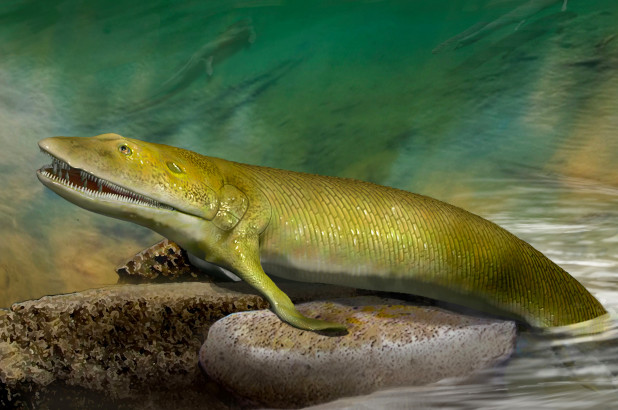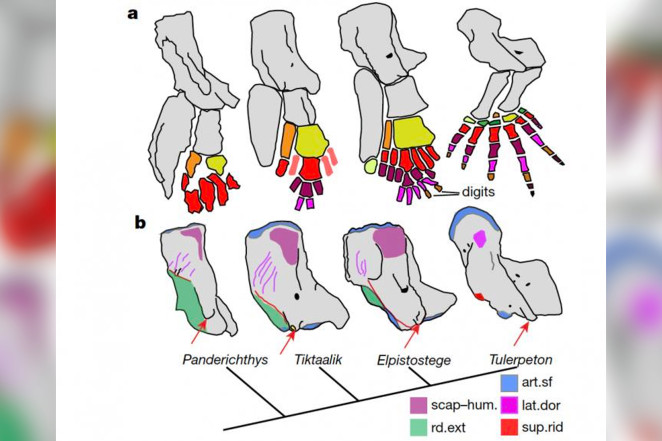3.8亿年前,有手指的鱼可能是人类的手进化过程中缺失的一环
3.8亿年前,有手指的鱼可能是人类的手进化过程中缺失的一环
A creepy fish with fingers on the end of its fins terrorized the oceans 380 million years ago.
3.8亿年前,一种鳍端有手指的令人毛骨悚然的鱼类在海洋中横行霸道。
The 5ft-long, shark-like Elpistostege watsoni lurked in tropical lagoons and could be a missing link in human evolution.
这条长5英尺、形似鲨鱼的Elpistostege鱼潜伏在热带泻湖中,可能是人类进化过程中缺失的一环。
Scientists studying a fossil of the slippery predator found in Canada say it may hold clues to how hands evolved in people.
科学家研究了在加拿大发现的一种滑溜溜的食肉动物化石,称它可能为人类的手是如何进化的提供了线索。

Scans of the fossil showed the structure of its fin to have similarities with the human hand, with the skeleton featuring an arm, a forearm and finger-like appendages.
对化石的扫描显示,它的鳍的结构与人类的手有相似之处,它的骨骼有手臂、前臂和手指状的附肢。
Researchers say their findings reveal “extraordinary new information” about how the human hand evolved.
研究人员表示,他们的发现揭示了关于人手进化的“非凡的新信息”。
Professor John Long, of Flinders University in Australia, said: “This is the first time that we have unequivocally discovered fingers locked in a fin with fin-rays in any known fish.”
澳大利亚弗林德斯大学的约翰·朗教授说:“这是我们第一次明确地、在任何已知的鱼身上、发现手指与鳍射线结合在一起的鳍。”
“The articulating digits in the fin are like the finger bones found in the hands of most animals.
“鳍上的关节手指就像大多数动物手上的指骨。”
“This finding pushes back the origin of digits invertebrates to the fish level and tells us that the patterning for the vertebrate hand was first developed deep in evolution, just before fishes left the water.”
这一发现将指类无脊椎动物的起源推回到了鱼类的水平,并告诉我们,脊椎动物手的模式最初是在进化的深处发展起来的,就在鱼类离开水之前。”
Evidence of Elpistostege was first found in 1938 in the cliffs of Miguasha National Park in Quebec, Canada.
1938年,在加拿大魁北克的米瓜沙国家公园的悬崖上,首次发现了Elpistostege的踪迹。
However, it was only in 2010 a complete specimen was discovered.
然而,直到2010年才发现了完整的标本。

The unique predator is believed to have lived in a shallow marine habitat in the Quebec region during the Middle and Upper Devonian period, about 393-359 million years ago.
这种独特的食肉动物被认为生活在大约3.93亿至3.59亿年前的中上泥盆世时期,生活在魁北克地区的浅海栖息地。
Researchers believe fish such as Elpistostege are “transitional fossils” which could help understand how vertebrates, or back-boned animals, were able to transition from water to land.
研究人员认为,像刺鱼这样的鱼类是“过渡性化石”,这可能有助于理解脊椎动物或背骨动物是如何从水过渡到陆地的。
The process would have involved significant changes such as the evolution of hands and feet.
这个过程可能会涉及重大的变化,比如手和脚的进化。
The research was published in the journal Nature.
这项研究发表在《自然》杂志上。
注:Elpistostegalia出现于Frasnian期(晚泥盆纪早期),有许多与两栖动物极其相似的特征。也许是过于特化了,古生物学者们一般把它们看作一个进化上的盲枝。它们与两栖动物相似的特征有:肛门的消失(只保留一个泄殖腔);背鳍的消失;肋骨形态的变化,头骨数量的减少,以及具有早期两栖动物的迷齿。
- 频道推荐
- |
- 全站推荐
- 推荐下载
- 网站推荐


















